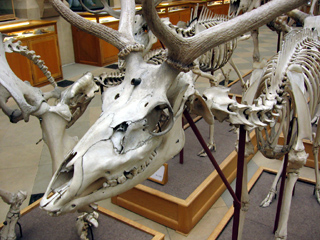Happy birthday Jonathan Morissette
Visiting the Oxford Natural History Museum with someone who shares an active interest in botany, archaeology, palaeontology, genetics, and geology is quite a fascinating experience. As such, doing so this morning with Antonia was both engaging and pleasant. Partly, the visit was motivated by the desire to see the Kakapo parrot but, since she went on a tour with one of the curators quite recently, she told me a lot more about the collection as well.
For the unfamiliar, the Natural History Museum is housed inside an attractive building on Parks Road, north of Wadham. The main hall is the kind of vaulted steel and glass structure that I associate with the great European exhibitions of the early 20th century: with crowds goggling over dinosaur skeletons. The collection is certainly quite good, spanning a respectable section of the animal and mineral variety of the planet. Especially worth seeing: elephant skeletons, some of the wide variety of stuffed raptors, the complete bluefin tuna skeleton, some of the large fossil and mineral samples, and the general architecture of the building itself. Note how every pillar in both the lower and upper galleries is made from a different stone, from a different part of the United Kingdom.
Behind the Natural History Museum, and presently under renovation, is the Pitt Rivers museum. A cynic might describe it as an exuberant assembly of the plunder of British aristocrats past. It includes a Haida totem poll, shrunken heads, and innumerable tools, weapons, religious artefacts, articles of clothing, and day-to-day objects from countries around the world. Unusually for a museum, objects are assembled by type, in cases spanning many times and cultures. That allows for an appreciation both of the variety of human creations, and the similar needs and products of diverse cultures. While not large, the place is literally packed, with narrow aisles between well-stuffed display cases. Antonia explained that both the Pitt Rivers and Natural History Museums have far too little space to display their full collections: a partial motivation for the ongoing renovation.
The general lesson – that museums are enormously better in the presence of interested others – is obvious enough. I am delighted that I had the chance to use that insight in practice.



Those outside Oxford who are interested in the museum can take a virtual tour on their website.
R.K.
Thanks. I was already considering both, though I have my doubts about lectures that cost money to attend.
Given the huge difficulty of keeping track of everything happening in Oxford (home of 47 Nobel prize winners), I always appreciate when people send suggestions.
Despite me having been here for 6 years, my mum still hasn’t fulfilled her desire to visit the Pitt Rivers museum. I keep telling her one day I’ll leave…
Does this mean that Antonia is the Xth romantic prospect in Oxford?
Here’s a talk you might enjoy:
“Fishing for nature: subjectivity and environment”
Dr Andrea Nightingale
Tuesday 16th May at 4.30pm
Board Room, Ground floor, OUCE, South Parks Rd
Geography Research Seminar Series
Also,
“Climate crime: will climate change destroy any hope of equality for the world’s poorest people?”
Maria Adebowale, Director of Capacity Global; Andrew Simms, New Economics Foundation
Thursday 18th May 7-9pm
Ruskin College. Located at the corner of Walton Street and Worcester Place. The meetings will be held in the Main Hall.
Coin Climate Speaker Series, in association with Oxfam Admission, £3/£2
B,
Xth is right. Depending on where we draw the distinction of prospect/non-prospect, the numbers vary dramatically.
Naturally, you understand that such issues are not the stuff of the public blog.
So I should hope.
I can’t help but find such dual confirmation intensely amusing.
I had a great time when we went to the Pitt Rivers and Natural History museums back in January – but then I’m easily pleased. Throw in a couple of shrunken heads and a few skeletons and I’ll be there for hours!
Kakapo chicks relocate to lnvercargill
April 09, 2009
Twenty one kakapo chicks have been taken to a special hand-rearing facility in Invercargill to secure their chances of survival.
The chicks are among the 34 which hatched on Whenua Hou/Codfish Island this breeding season, bringing the critically endangered kakapo population to 125.
Pitt Rivers Museum reopens
05 May 09
The Pitt Rivers Museum reopened to the public last week after a star-studded reception.
The popular museum was closed for ten months to enable a remodeling of its entrance and improvements to its education facilities and environment.The £1.5 million redevelopment allows visitors to appreciate afresh the significance of this extraordinary collection. In addition there are eight new case displays focusing on art and decorative techniques, including three new cases on Australian Aboriginal art.
At Thursday night’s reception to thank those who had funded the Pitt Rivers redevelopment, Sir David Attenborough enthused about the unique qualities that attract so many visitors to the distinctive Museum.
The Vice Chancellor Dr John Hood opened the event by thanking the project funders, in particular Carole Souter of the Heritage Lottery Fund who had provided the opening gift of £1m.Michael O’Hanlon, the Museum’s Director, said: ‘It is wonderful to be back in business, with a restored entrance panorama, new displays, fresh education space and a queue outside even before the doors opened. We are so lucky in having the generous support that we enjoy from such a wide range of individuals, trusts and foundations.’
Philip Pullman, Michael Palin and Anthony Pitt-Rivers – the great, great grandson of founder General Augustus Pitt Rivers – and his wife Valerie were amongst other distinguished guests present who enjoyed the new displays and the view from the new Clore Learning Balcony.
May Day offered a special extended opening until 7pm, with live traditional music and a chance to chat to staff and find out about the changes that have been made to Pitt Rivers Museum’s new entrance following its refurbishments. Over the weekend families were invited to the re-launch of popular Saturday afternoon Pitt Stop activities, the new ‘back pack’ of family activities and the Mouse trail, much loved by visitors young and old. For other visitors there were a selection of free gallery talks covering the new displays, the Museum’s history, tools and metalworking, as well as insiders’ tours of ‘favourite things’ led by the Friends of the Museum.
“Sadly, not only has the kakapo forgotten how to fly, but it has also forgotten that it has forgotten how to fly. Apparently a seriously worried kakapo will sometimes run up a tree and jump out of it, whereupon it flies like a brick and lands in a graceless heap on the ground.”
Douglas Adams, Last Chance to See.
“Happy, little green parrot who calmly burrows through the still-living flesh of sheep and dines upon their kidney fat while they lay bleating in terror. No, really.”
““Climate crime: will climate change destroy any hope of equality for the world’s poorest people?”
Maria Adebowale, Director of Capacity Global; Andrew Simms, New Economics Foundation
Thursday 18th May 7-9pm”
Did anyone attend this?
The kakapo’s downfall began with New Zealand’s first wave of human colonisation, some 700 years ago, by Polynesians. These arrivals hunted it, and also brought rats with them, which ate nestling chicks. The second, European wave of immigrants brought cats and stoats to add to the birds’ woes. Humans also destroyed much of their habitat to make way for crops. Conservation efforts are not assisted by the birds’ reproductive habits. They feed their chicks on the fruit of the rimu, a tree that produces its nutrient-rich morsels only every two or three years. These trees all fruit simultaneously during what are known as mast years. This means the kakapo can breed only during mast years.
With all these strikes against them it is little surprise that by the early 1970s the kakapo was thought to be extinct. But then two remnant groups were found in the south of the country. These were relocated and now live on three small, predator-free islands. After a troubled start, which saw the population hit a low of 51, this recovery programme has raised it to 123 adults.
…
Kakapo mating is theatrical. Uniquely for parrots, they are lek-breeders. This means that the males advertise their eligibility in competitive displays for choosy females. Males scrape bowl-shaped depressions in the ground on a hilltop. Over subsequent nights they sit in or near their bowls, inflate specialised air sacs, and emit deep booms. Females, attracted by the serenades, approach the bowls along tracks the males have prepared by clearing and trimming the vegetation. An interested female may stop and mate with a male. An uninterested one will move on to appraise another suitor.
Pitt Rivers Museum
Pitt Rivers museum: so many drawers, so little time
Off with the heads: Pitt Rivers Museum removes human remains from display | Museums | The Guardian
https://www.theguardian.com/culture/2020/sep/13/off-with-the-heads-pitt-rivers-museum-removes-human-remains-from-display